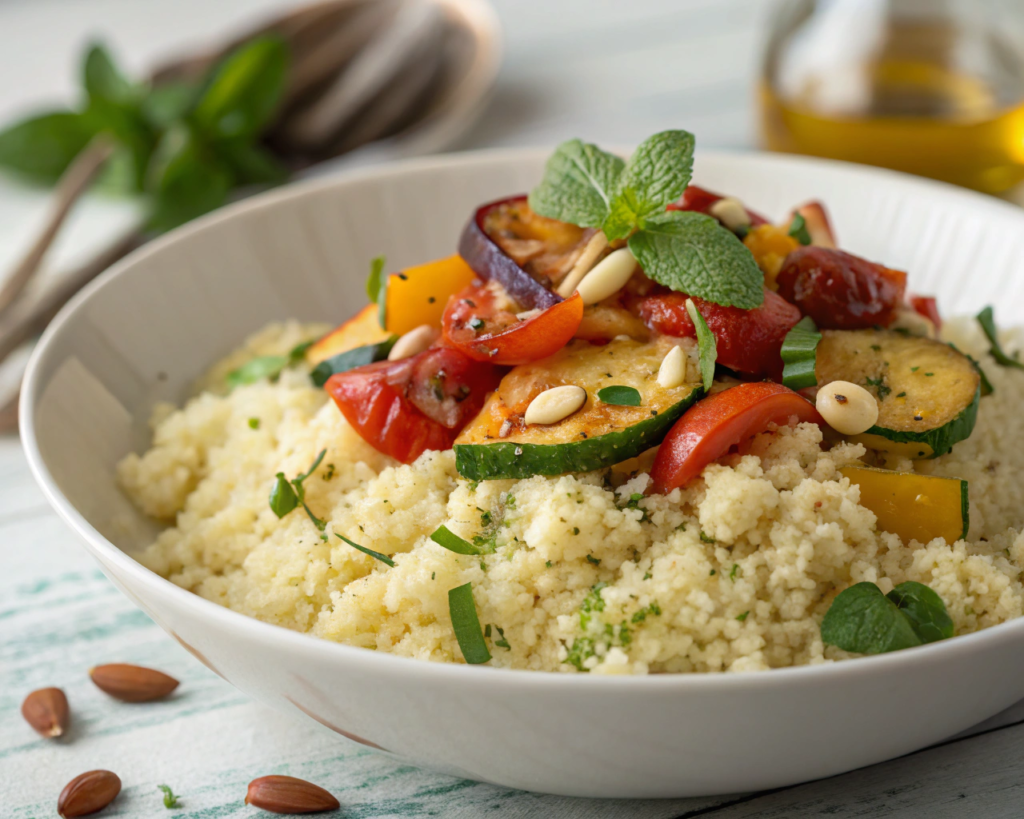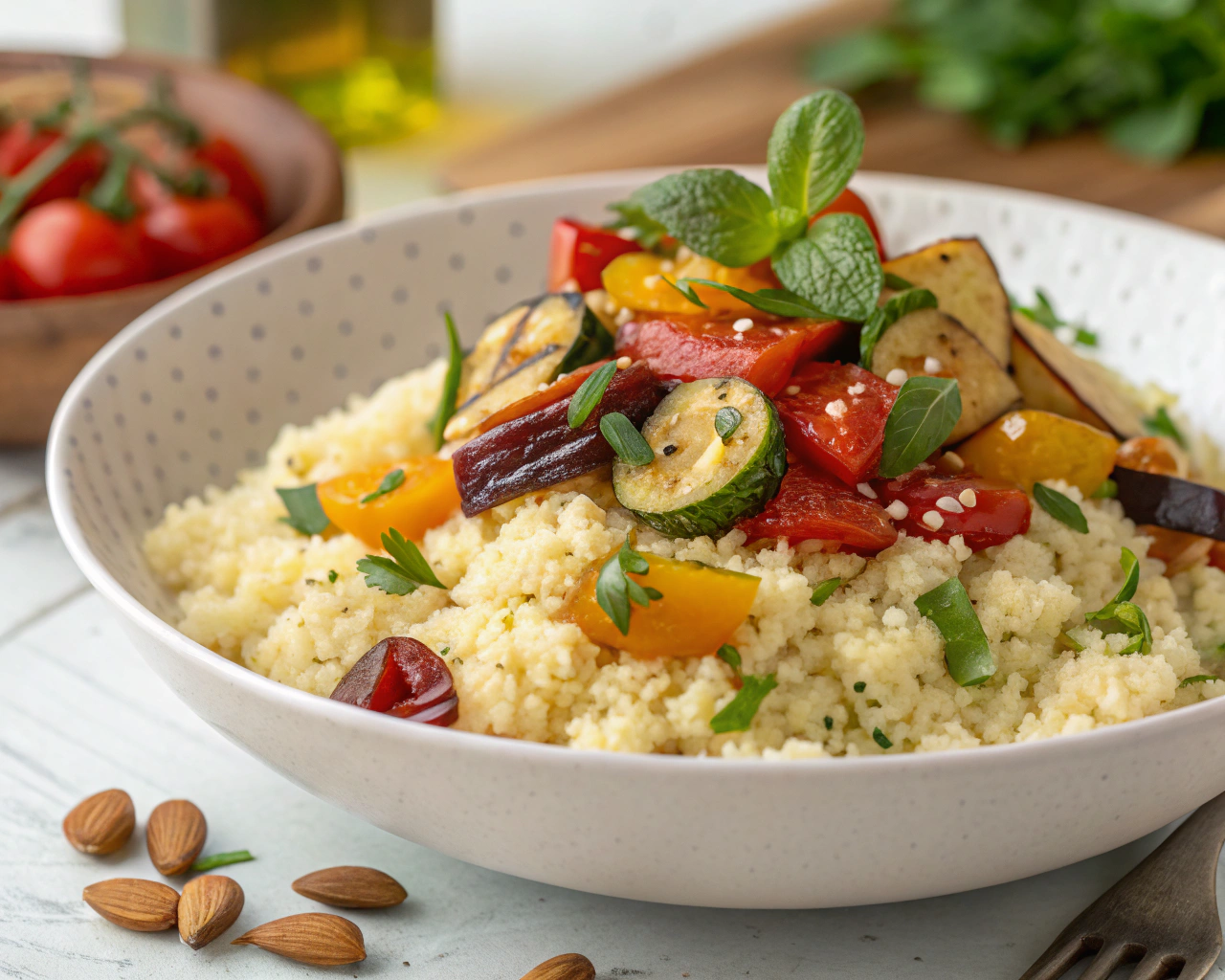Couscous, a tiny yet mighty grain, is an incredibly versatile, nutrient-rich, and simple-to-prepare ingredient that has the power to transform any meal into something special. Whether you’re in need of a quick and satisfying weeknight dinner, a comforting and hearty side dish, or a light and refreshing salad, couscous is the perfect solution to meet your culinary needs. With the help of these carefully curated recipes and practical tips, you’ll be equipped to whip up mouthwatering couscous creations that are sure to delight your family and friends. From savory main courses to sweet and innovative dishes, couscous offers endless opportunities to experiment and impress. So, don’t wait any longer—grab a bag of couscous, roll up your sleeves, and dive into the kitchen. Your exciting culinary journey is just beginning, and the couscous recipes are truly endless!
Table of Contents
What is Couscous?
Couscous is a type of tiny, granular pasta made from semolina wheat, and it holds a special place in the culinary traditions of North Africa and the Middle East. For instance, it is a staple dish in countries like Morocco, Algeria, Tunisia, and Libya, where it is commonly served alongside a variety of vegetables, meats, and richly flavored sauces. Not only is couscous versatile, but it also allows for endless culinary creativity, as it can be enjoyed in countless ways, from simple side dishes to elaborate main courses.
Each variety of couscous brings its own character to the table, allowing cooks to experiment with different textures and flavors. For example, if you’re preparing a traditional North African tagine, Moroccan couscous pairs beautifully with the rich and spiced sauces. Similarly, a refreshing Mediterranean salad can benefit from the chewy texture of pearl couscous, while a comforting stew might be elevated by the heartiness of Lebanese couscous. Furthermore, its ease of preparation, combined with its ability to absorb flavors, makes it a beloved ingredient in kitchens around the world.
For more inspiration, explore these 10 creative couscous recipes that will take your meals to the next level.
Health Benefits of Couscous
Couscous is not only delicious but also packed with nutrients. Here are some of its health benefits:
- Rich in Complex Carbohydrates: Couscous provides a steady source of energy, making it an excellent choice for active individuals.
- High in Protein: It contains a good amount of plant-based protein, essential for muscle repair and growth.
- Low in Fat: Couscous is naturally low in fat, making it a healthy option for those watching their calorie intake.
- Rich in Vitamins and Minerals: It’s a good source of B vitamins, selenium, and magnesium, which support overall health and well-being.
- Gluten-Free Options Available: For those with gluten intolerance, there are gluten-free versions made from corn or rice.
How to Cook Couscous
Cooking couscous is incredibly simple and quick. Here’s a basic method:
Boil the Liquid:
In a small saucepan, bring the water or broth to a boil. Add a pinch of salt and a drizzle of olive oil or a pat of butter for extra flavor and richness.
Add the Couscous:
Once the liquid is boiling, remove the saucepan from the heat and stir in the couscous. Ensure all the grains are submerged in the liquid.
Cover and Let It Steam:
Cover the saucepan with a tight-fitting lid and let the couscous sit for about 5 minutes. This allows the grains to absorb the liquid and become tender.
Fluff with a Fork:
After 5 minutes, remove the lid and fluff the couscous gently with a fork to separate the grains and prevent clumping.
Serve or Customize:
Your couscous is now ready to serve as a side dish or base for other ingredients. You can also customize it by adding herbs, spices, vegetables, or proteins to create a complete meal.
Couscous Recipes
Now that you know the basics, let’s dive into some delicious couscous recipes that cater to different tastes and occasions.
1. Classic Moroccan Couscous
Ingredients:
- 1 cup Moroccan couscous
- 1.5 cups vegetable broth
- 1 tablespoon olive oil
- 1 teaspoon ground cumin
- 1 teaspoon paprika
- 1/2 teaspoon cinnamon
- 1/2 cup chopped carrots
- 1/2 cup chopped zucchini
- 1/2 cup chickpeas (canned or cooked)
- Salt and pepper to taste
- Fresh parsley for garnish
Instructions:
- In a pot, bring the vegetable broth to a boil.
- Stir in the couscous, olive oil, cumin, paprika, cinnamon, salt, and pepper.
- Remove from heat, cover, and let sit for 5 minutes.
- In a separate pan, sauté the carrots, zucchini, and chickpeas until tender.
- Fluff the couscous with a fork and mix in the sautéed vegetables.
- Garnish with fresh parsley and serve warm.
2. Mediterranean Couscous Salad
Ingredients:
- 1 cup Israeli couscous
- 1.5 cups water
- 1/2 cup cherry tomatoes, halved
- 1/2 cup cucumber, diced
- 1/4 cup red onion, finely chopped
- 1/4 cup Kalamata olives, sliced
- 1/4 cup feta cheese, crumbled
- 2 tablespoons olive oil
- 1 tablespoon lemon juice
- 1 teaspoon dried oregano
- Salt and pepper to taste
Instructions:
- Cook the Israeli couscous according to the package instructions.
- In a large bowl, combine the cooked couscous, cherry tomatoes, cucumber, red onion, olives, and feta cheese.
- In a small bowl, whisk together the olive oil, lemon juice, oregano, salt, and pepper.
- Pour the dressing over the couscous mixture and toss to combine.
- Serve chilled or at room temperature.
3. Spicy Harissa Couscous with Shrimp
Ingredients:
- 1 cup Moroccan couscous
- 1.5 cups chicken broth
- 1 tablespoon olive oil
- 1 tablespoon harissa paste
- 1/2 pound shrimp, peeled and deveined
- 1/2 cup bell peppers, sliced
- 1/2 cup onion, sliced
- 2 cloves garlic, minced
- Salt and pepper to taste
- Fresh cilantro for garnish
Instructions:
- In a pot, bring the chicken broth to a boil.
- Stir in the couscous, olive oil, harissa paste, salt, and pepper.
- Remove from heat, cover, and let sit for 5 minutes.
- In a skillet, sauté the shrimp, bell peppers, onion, and garlic until the shrimp is cooked through.
- Fluff the couscous with a fork and mix in the sautéed shrimp and vegetables.
- Garnish with fresh cilantro and serve warm.
4. Lemon Herb Couscous with Grilled Chicken
Ingredients:
- 1 cup Lebanese couscous
- 1.5 cups water
- 2 tablespoons olive oil
- 1 tablespoon lemon zest
- 2 tablespoons lemon juice
- 1 teaspoon dried thyme
- 1 teaspoon dried rosemary
- 1/2 teaspoon garlic powder
- Salt and pepper to taste
- 2 grilled chicken breasts, sliced
- Fresh parsley for garnish
Instructions:
- Cook the Lebanese couscous according to the package instructions.
- In a large bowl, combine the cooked couscous, olive oil, lemon zest, lemon juice, thyme, rosemary, garlic powder, salt, and pepper.
- Toss to combine and adjust seasoning if needed.
- Serve the couscous topped with sliced grilled chicken and garnished with fresh parsley.
5. Sweet Couscous with Dried Fruits and Nuts
Ingredients:
- 1 cup Moroccan couscous
- 1.5 cups almond milk
- 1 tablespoon honey
- 1/2 teaspoon cinnamon
- 1/4 cup dried apricots, chopped
- 1/4 cup raisins
- 1/4 cup almonds, chopped
- 1/4 cup pistachios, chopped
- Fresh mint for garnish
Instructions:
- In a pot, bring the almond milk to a boil.
- Stir in the couscous, honey, and cinnamon.
- Remove from heat, cover, and let sit for 5 minutes.
- Fluff the couscous with a fork and mix in the dried apricots, raisins, almonds, and pistachios.
- Garnish with fresh mint and serve warm or chilled.
check out this beginner’s guide to couscous recipes perfectly.
Tips for Cooking with Couscous
Choose the Right Type of Couscous
- Regular Couscous: The most common type, perfect for quick meals and side dishes.
- Pearl Couscous: Larger grains with a chewy texture, ideal for salads and heartier dishes.
- Whole Wheat Couscous: A healthier option with more fiber and nutrients.
Use Broth Instead of Water
Cooking couscous in vegetable, chicken, or beef broth adds depth and richness to its flavor. This simple swap can make a big difference!
Toast the Couscous
Toasting couscous in a dry pan or with a little oil before adding liquid enhances its nutty flavor. Stir frequently to avoid burning.
Fluff It Up
After cooking, always fluff the couscous with a fork to separate the grains and prevent clumping. This ensures a light and fluffy texture.
Add Fresh Herbs and Spices
Incorporate fresh herbs like parsley, cilantro, or mint, or spices like cumin, paprika, or cinnamon to infuse the couscous with vibrant flavors.
Mix in Vegetables and Proteins
Stir in roasted vegetables, grilled chicken, chickpeas, or shrimp to turn couscous into a complete, balanced meal.
Experiment with Sweet and Savory
Couscous isn’t just for savory dishes! Try it in sweet recipes by cooking it with milk, honey, and dried fruits for a unique dessert or breakfast option.
Make It Ahead
Couscous is great for meal prep. Cook a large batch and store it in the fridge for up to 3 days. Reheat gently with a splash of water or broth to refresh it.
Use It as a Base
Serve couscous as a base for stews, curries, or grilled meats. Its mild flavor complements bold and saucy dishes perfectly.
Add Texture
Mix in crunchy elements like toasted nuts, seeds, or crispy fried onions to contrast the soft texture of couscous.
Keep It Simple
Sometimes less is more. A drizzle of olive oil, a squeeze of lemon juice, and a sprinkle of salt and pepper can make a delicious, simple side dish.
Try Cold Couscous Salads
Couscous works wonderfully in cold salads. Toss it with chopped veggies, a tangy vinaigrette, and feta cheese for a refreshing meal.
Don’t Overcook
Couscous cooks quickly, so avoid overcooking it. Once the liquid is absorbed and the grains are tender, it’s ready to go.

Conclusion
Couscous is an incredibly versatile, nutrient-rich, and simple-to-prepare ingredient that has the power to transform any meal into something special. Whether you’re in need of a quick and satisfying weeknight dinner, a comforting and hearty side dish, or a light and refreshing salad, couscous is the perfect solution to meet your culinary needs. With the help of these carefully curated recipes and practical tips, you’ll be equipped to whip up mouthwatering couscous creations that are sure to delight your family and friends. From savory main courses to sweet and innovative dishes, couscous offers endless opportunities to experiment and impress. So, don’t wait any longer—grab a bag of couscous, roll up your sleeves, and dive into the kitchen. Your exciting culinary journey is just beginning, and the possibilities are truly endless!

